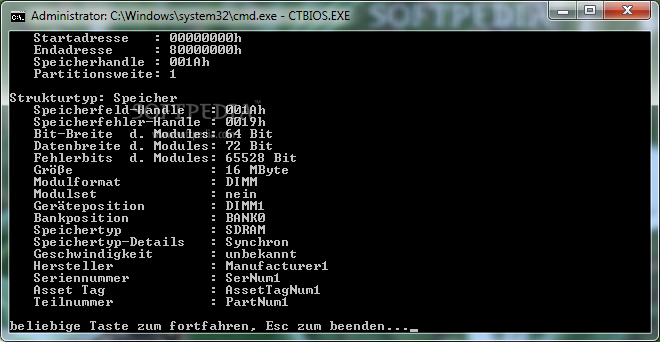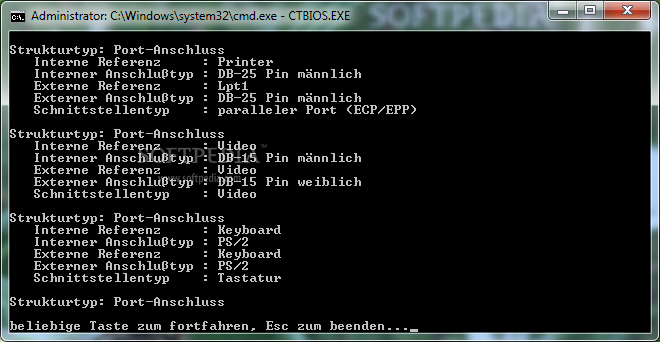The Software Method
Descargar Ctbios gratis en Waxoo.com, Descargas directas 100% seguras, Descarga Ctbios. Download Now: Download CtBIOS Now! Downloads: 7527: Category: Optimizers & Diagnostics; Date Added: Thursday, 7th July 2005: Last Updated: Saturday, 10th September 2005. CTBIOS v1.5 reveals much more information than its earlier version did, but it cannot find something that is not there. Once again, we resort to the web search for the board model 6VIA81 or to Wim's BIOS Site for a lookup on the manufacturer ID X3. Wim identifies the X3 code as belonging to A-Corp, and this finding is easily verified by the web. Ctbios.zip: 35k: CTBIOS reads 1997 or older bios ids to report the manufacturer: biosr11.zip: 15k: Bios Reporter displays each address flag in extensive detail: pcm140.zip: 75k: Post Code Master defines 2 digit codes from Post Cards: mrdeco.zip: 10k: Decompressor for Microid Research BIOS: peodeco.zip: 10k: Decompressor for Phoenix NuBIOS (1995. Download CTBIOS Bios Info 1.0 by Andreas Stiller VETUSWARE.COM the biggest free abandonware downloads collection in the universe.
Sometimes, there is no help to be found either on the board or in the startup display. If that is your situation, don’t despair yet! We still have one more trick to try – we can “ask” the mainboard who it is, and who made it.

AMI offers a freeware mainboard (BIOS) identification utility that, although written specifically for the AMI BIOS’es, is only able to extract a very limited range of information. This utility is available for download at AMI’s Bios support site. The following page, http://www.ami.com/support/bios.html, offers AMI’s manufacturer code list as well as links for the ID utility and post- and beep-code references.
The ID utility (AMIMBID.EXE) is a compact (94Kb) file that must be run from a pure DOS session. It will read the data stored on the BIOS chip and display the relevant portion of that data on-screen. It will also write a text file (RESULTS.TXT) that contains most of the information displayed. Figure 7 below illustrates the data written to the text file for the mainboard discussed in the previous section.
Note that the BIOS ID string extracted is not quite the same as what was displayed on system startup. The boot display included the Project Tag, which is shown separately in the text file. Note also that this utility does not provide a manufacturer’s name if the Manufacturer Code does not match a database entry. As was the case in earlier examples, a web search is in order for final determination of the board maker.
Needless to say, these results below are less than ideal, and not helpful at all if the board uses Award BIOS. In that case, I suggest the use of CTBIOS, another mobo ID utility. This one is the (freeware) product of c’t, the leading PC enthusiast’s magazine in Germany, and can be found at their website, http://www.heise.de/ct/english/. Of course, most of the site’s pages are in German, so I’ll give another link for this utility, http://bootdisk.com/. This site is chock-full of useful tools besides CTBIOS, so check it out carefully.
| Figure 7 – AMIMBID results as written to disk |
This utility above will extract useful data from both AMI and Award BIOS’es, and it does a fairly good job of providing the board maker’s name and web address.
Compare Figures 8 and 9 below.

Ctbi Stock
Figure 8 show the output of CTBIOS v1.3, while Figure 9 shows the same system when examined by CTBIOS v1.5. In either case, it is evident that the board does not carry its maker’s name in its BIOS chip. CTBIOS v1.5 reveals much more information than its earlier version did, but it cannot find something that is not there.

Once again, we resort to the web search for the board model 6VIA81 or to Wim’s BIOS Site for a lookup on the manufacturer ID X3. Wim identifies the X3 code as belonging to A-Corp, and this finding is easily verified by the web search.
| Figure 8 – CTBIOS v1.3 results as displayed |
Cmospwd Windows 7
| Figure 9 – CTBIOS v1.5 results as displayed for same system as shown in Figure 8 |
Bios V1.5
In Conclusion
With all of the high-level system diagnostic utilities I have at my disposal, I still end up returning to these tried-and-true routines when I need to know whose product is in the machine. The utilities that I have recommended here are all freeware, readily available for download, and are easily run by executing their filenames at a command prompt. They will all return the desired information as on-screen displays. These factors combine to make them my utilities of choice for mainboard identification.
One of the obvious questions that may have occurred to you by now is “Why not skip all of this and go right to the BIOS producer’s site for information?” Well, the short and sweet answer is that both AMI and Award will simply direct you to go to the mainboard maker for any BIOS support issues. Remember, the whole intent of this exercise was to identify the board maker. If we don’t know who the board maker is well, you get the idea.
Ctbios 1.5
I certainly hope that some of this will make your next mainboard identification task just a little bit simpler.
Ctbisd
This page: Identification of motherboards by software
